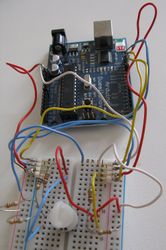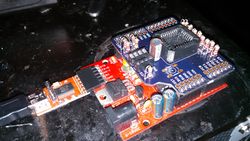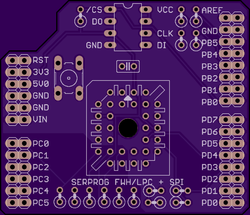Serprog/Arduino flasher: Difference between revisions
(Added note that resistor dividers arent good for ISPing) |
(Include build info for the Arduino Mega branch) |
||
| Line 2: | Line 2: | ||
<div class="boilerplate" style="background-color: red; margin: 2em 0 0 0; padding: 0 10px 0 10px; border: 1px dotted #aaa;">'''WARNING, make sure that the Arduino SPI voltages and the flash chip voltages matches: Without any extra resistors or level shifter, the Arduino Uno and Duemillanove SPI pins are at 5V, while most chips operate at 3.3v.'''</div> | <div class="boilerplate" style="background-color: red; margin: 2em 0 0 0; padding: 0 10px 0 10px; border: 1px dotted #aaa;">'''WARNING, make sure that the Arduino SPI voltages and the flash chip voltages matches: Without any extra resistors or level shifter, the Arduino Uno and Duemillanove SPI pins are at 5V, while most chips operate at 3.3v.'''</div> | ||
== Hardware basics == | == Hardware basics == | ||
You'll need to have a supported Arduino, | You'll need to have a supported Arduino, are primarily | ||
any based on the ATmega328 (/168/88 will work with small changes too), | any based on the ATmega328 (/168/88 will work with small changes too), | ||
like the Arduino Uno R3. Best performance is available with | like the Arduino Uno R3. Best performance is available with | ||
one with an FTDI usb-serial chip (older ones, sparkfun redboard, etc). | one with an FTDI usb-serial chip (older ones, sparkfun redboard, etc). | ||
The Arduino Mega and Mega2560 are also supported, but notice that | |||
the software has a different branch for them. | |||
And unless the Arduino is a 3.3V version (rare, and the firmware would | And unless the Arduino is a 3.3V version (rare, and the firmware would | ||
| Line 11: | Line 14: | ||
you'll also need a way to convert the 5V logic levels to 3.3V, | you'll also need a way to convert the 5V logic levels to 3.3V, | ||
but check that your flash chip is 3.3V and not 1.8V - that would | but check that your flash chip is 3.3V and not 1.8V - that would | ||
need level conversion in both directions and is not | need level conversion in both directions and is not covered | ||
here, yet. | here, yet. | ||
| Line 97: | Line 100: | ||
For a board with an ftdi: | For a board with an ftdi: | ||
$ make ftdi && make flash-ftdi | $ make ftdi && make flash-ftdi | ||
=== Building for the Mega1280 or 2560 === | |||
As above, except use the branch for the 1280: | |||
$ git clone --recursive git://github.com/urjaman/frser-duino -b arduino-mega-1280 | |||
For the Mega2560, change the Makefile to target the correct MCU (replace 1280 with 2560). | |||
==== Running flashrom ==== | ==== Running flashrom ==== | ||
Revision as of 18:08, 1 February 2016
Hardware basics
You'll need to have a supported Arduino, are primarily any based on the ATmega328 (/168/88 will work with small changes too), like the Arduino Uno R3. Best performance is available with one with an FTDI usb-serial chip (older ones, sparkfun redboard, etc).
The Arduino Mega and Mega2560 are also supported, but notice that the software has a different branch for them.
And unless the Arduino is a 3.3V version (rare, and the firmware would need small modifications (like MCU frequency) to run on one), you'll also need a way to convert the 5V logic levels to 3.3V, but check that your flash chip is 3.3V and not 1.8V - that would need level conversion in both directions and is not covered here, yet.
And an SPI flash chip that is supported by flashrom.
There are some simple schematics included here. The idea is that you pick one version from each part 1 through 3, and connect the pin/net names.
Part 1: The Arduino
ATmega328 based ones:
Part 2: Level translation
There are a few options here, ranging from the simple resistors (v1) to a buffer chip (v3).
One thing to remember about the resistor dividers is that they're not strong enough to do ISP.
Here's the simple resistors:
The part count for the resistor divider is 6 resistors of 2 types or 9 of one type.
Here's one with 5 resistors, the downside is that you'll need to modify the firmware a little:
The 3rd version is using the DIP16 HEF4050 buffer chip:
Part 3: The SPI Flash chip
The smaller DIL-8 and SOIC-8 versions connect like this:
Gallery of some flashers
Alternative: Shield with SPI and LPC/FWH for 5V Arduinos
Firmware and hardware sources Shield PCB shared at oshpark
- This shield and firmware was built for 5V arduinos with FTDI, variations to that will need adaptations in building the shield and/or in the firmware.
- This shield uses a different pin for SPI CS than the other circuits on this page, and has LPC/FWH capability, thus different firmware.
- Note: do check for any incompatibilities between your arduino and the shield, eg. the PD7 used as LPC CLK clashes with BT reset in BT arduinos.
- For LPC/FWH, current (15/03/25) flashrom trunk will not work, until that is fixed use this branch instead.
Software and setup
The Arduino Uno R3 and other arduinos with an ATmega8U2/16U2 as an usb-serial converter have lots of bugs in their usb-serial firmware that prevent it from operating at more than a limited 115200 baud. The frser-duino firmware works around this by default if you use the appropriate make target, but there exists a firmware that allows these to be used like the FTDI at 2Mbaud: [1].
Setup
Required software
To make it work you need:
- A recent flashrom with the serprog protocol compiled in (most packaged versions do)
- frser-duino which runs on the arduino
- This page used to link to serprog-duino, frser-duino should build in a similar fashion and has better serial buffering and some other features (spi speed setting).
- The avr toolchain(avr-gcc, avr-libc,make etc...)
Building the software
First get the firmware source:
$ git clone --recursive git://github.com/urjaman/frser-duino $ cd frser-duino
Then build it:
For a board with a 8u2 or a 16u2:
$ make u2 && make flash-u2
For a board with an ftdi:
$ make ftdi && make flash-ftdi
Building for the Mega1280 or 2560
As above, except use the branch for the 1280:
$ git clone --recursive git://github.com/urjaman/frser-duino -b arduino-mega-1280
For the Mega2560, change the Makefile to target the correct MCU (replace 1280 with 2560).
Running flashrom
The right flashrom arguments are explained in the README.md, or here:
Available targets: ftdi, flash-ftdi: For the Arduinos with an FTDI compatible flashrom arguments: flashrom -p serprog:dev=/dev/ttyUSB0:2000000 Other boards using an hardware USB<->Serial converter might work too. u2, flash-u2: For the Arduino with a 8u2 or a 16u2 compatible flashrom arguments: flashrom -p serprog:dev=/dev/ttyACM0:115200
So for a board that has an ftdi that would give:
flashrom -p serprog:dev=/dev/ttyUSB0:2000000
Speed
The speed is very dependant on the flash chip used:
- Its capacity impacts the speed a lot, as you would expect.
- The chip model as also a huge impact.
Duemillanove
With the duemillanove:
# time flashrom -p serprog:dev=/dev/ttyUSB0:2000000 -r duemillanove.rom flashrom v0.9.7-r1711 on Linux 3.18.3-gnu-1 (i686) flashrom is free software, get the source code at http://www.flashrom.org Calibrating delay loop... delay loop is unreliable, trying to continue OK. serprog: Programmer name is "serprog-duino" Found Winbond flash chip "W25Q32.V" (4096 kB, SPI) on serprog. Reading flash... done. flashrom -p serprog:dev=/dev/ttyUSB0:2000000 -r duemillanove.rom
we have:
4.23s user 0.29s system 8% cpu 56.010 total
Uno
With the Arduino uno:
# flashrom -p serprog:dev=/dev/ttyACM0:115200 -r uno.rom flashrom v0.9.7-r1711 on Linux 3.18.3-gnu-1 (i686) flashrom is free software, get the source code at http://www.flashrom.org Calibrating delay loop... delay loop is unreliable, trying to continue OK. serprog: Programmer name is "serprog-duino" Found Winbond flash chip "W25Q32.V" (4096 kB, SPI) on serprog. Reading flash... done. flashrom -p serprog:dev=/dev/ttyACM0:115200 -r uno.rom
we have:
4.77s user 0.65s system 1% cpu 6:02.43 total
Tested chips
- SST25VF016B => huge issues, not recognized by the 3.3v version, had to use the 5v version which is over maximum allowed voltage, also had to lower the serial speed to 115200, ultra slow to write(seem related to the chip itself, since that with the openmoko programmer it's even slower...)...
- W25X80 works well in 3.3v mode(5v works also but it's highly not advised to use 5v)







